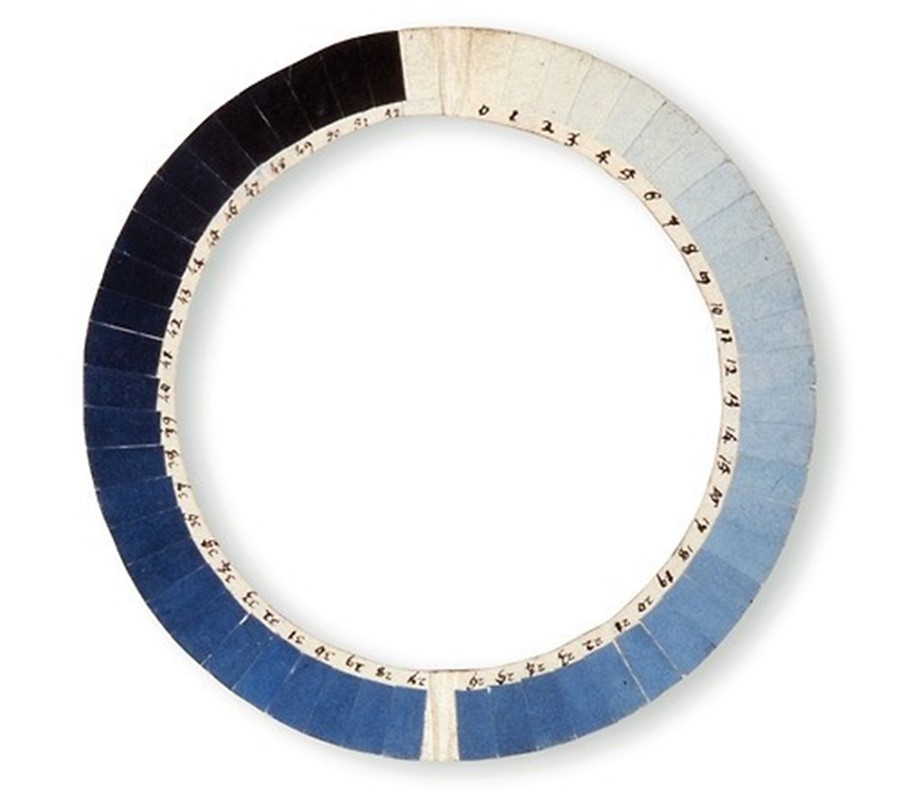Following a glorious summer of clear skies, a 1789 cyanometer for measuring the blueness of the sky, has been voted this week's Most Loved post
This summer, the warmest in a long time, we have been particularly lucky in the number of blue sky days we've seen. Perhaps this is why this week's Most Loved post – a 1789 cyanometer for measuring the blueness of the sky, chosen by visual director for Stella McCartney, Jonathan Schofield – has been so joyfully received.
The cyanometer is attributed to Horace-Bénédict de Saussure and Alexander von Humboldt. Cyanometers are made from squares of paper dyed in graduated shades of blue and arranged in an open circle or square for easy comparison with the sky's colour when held up against it. De Saussure is credited with the cyanometer's invention in 1789. His, like the one seen here, had 53 coloured sections – ranging from white through varying shades of blue to black – and was circular in shape. An Alpine traveller as well as a physicist, he used the device to measure the colour of the sky in Geneva, Chamonix and Mont Blanc, eventually coming to the correct conclusion that the colour of the sky was dependent on the amount of suspended particles in the atmosphere. Humboldt was also a zealous exponent of the cyanometer, using it on a number of expeditions to South America.
Blue is a mysterious, transient colour and yet it is the deepest in the colour spectrum. It is the most insubstantial colour and rarely occurs in the natural world except as a translucency. Light blue is considered the colour of meditation and as it darkens it becomes the colour of dreams. It evokes the idea of eternity and is traditionally associated with heaven and the Virgin Mary in Christian art. Many later artists were also transfixed with blue and its ethereal connotations – from Kandinsky to Picasso to Yves Klein – while Comme des Garçons released their Blue series of fragrances for summer 2013, offering an olfactory take on the colour.
Here, we catch up with Schofield to find out why he chose to Love this cyanometer, his favourite blue moments in art and what he is looking forward to this autumn.
"I chose the cyanometer, because I loved the idea that something so intangible as the blue sky could be measured"
Why did you choose to Love this Cyanometer?
I chose the cyanometer, because I loved the idea that something so intangible as the blue sky could be measured. It kind of says something about human vanity, that we want to try and quantify the impossible. It's a bit like asking someone how much they love you. It was a little bit melancholy, but it's also very beautiful.
What is your favourite blue moment in art history?
1. Matisse – the blues in his paintings, particularly the ones in the MOMA are unbelievable. It would take a lot longer than I have here to even start to describe how good Matisse is at blue.
2. A portrait by Ingres of Josephine Eleonore, Princesse de Broglie. It's at the Metropolitan Museum in New York. It's the most amazing blue satin dress.
3. Derek Jarman's film Blue is really good.
4. Francis Bacon's dark blues in his 50s paintings, Soho blues... sober and powerful, like a good suit.
5. A blue in a painting by Willem De Kooning called Suburb in Havana.
What's your favourite colour to wear?
My favourite colour to wear is navy blue. I find it calming and exciting at the same time.
Where's your favourite place in the world to look at the sky?
London.
What's your favourite season, sky-wise? And do you prefer the sky at night or during the day?
A warm September – exactly like the one we are having – and I prefer the hours of 5-8pm to look at the sky.
What are you looking forward to about autumn?
I'm looking forward to buying lots of identical navy blue cashmere sweaters and wearing them constantly. When they get holes in the elbows, I know spring is coming.
What's the last thing you bought?
The last thing I bought was a pair of white Saint Laurent Paris trainers – they look good with blue!
